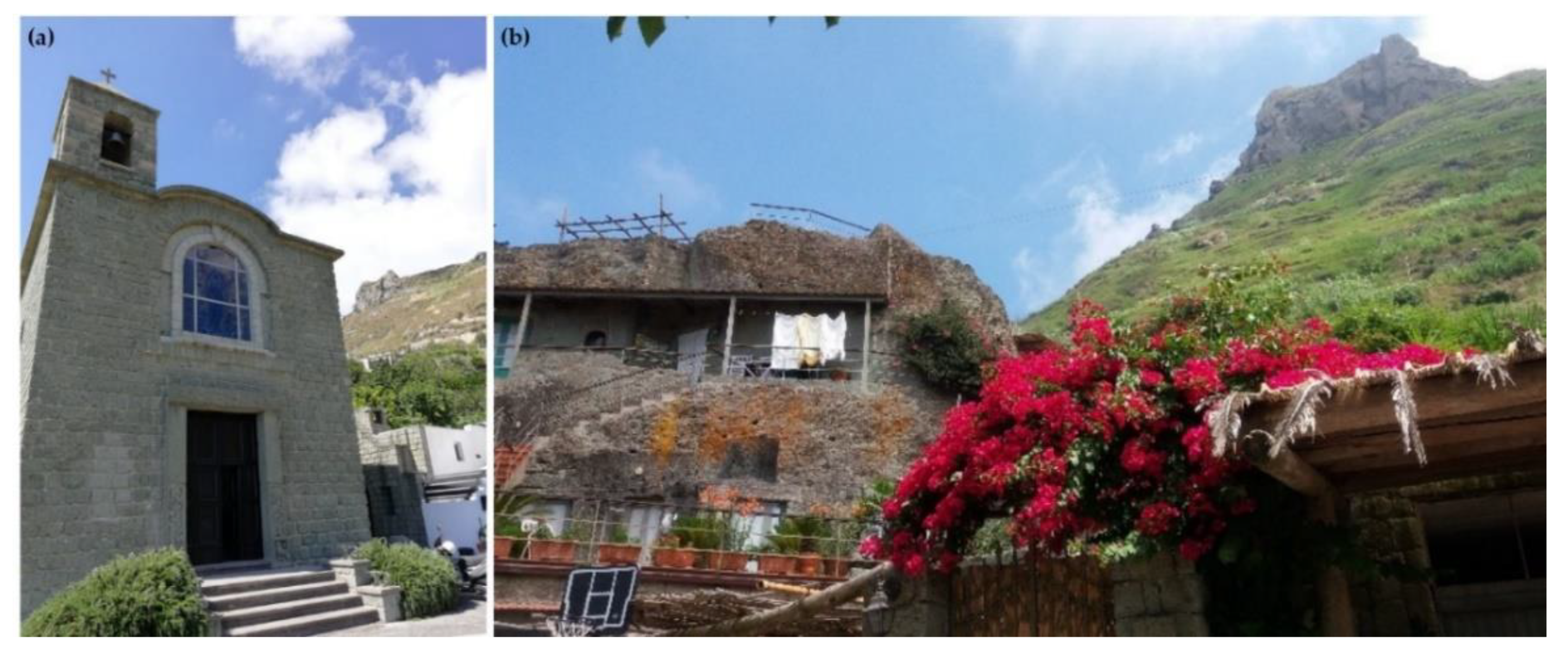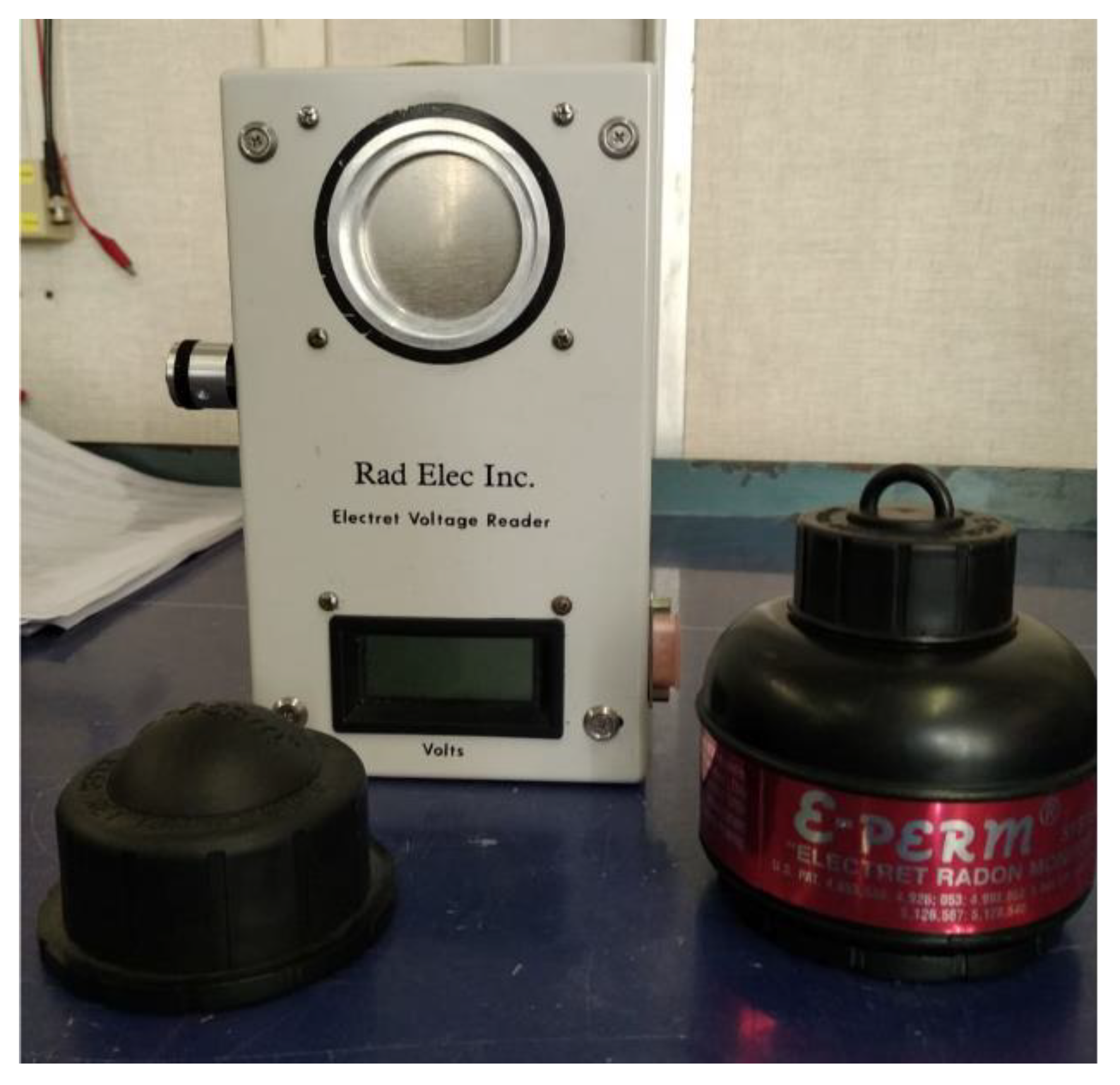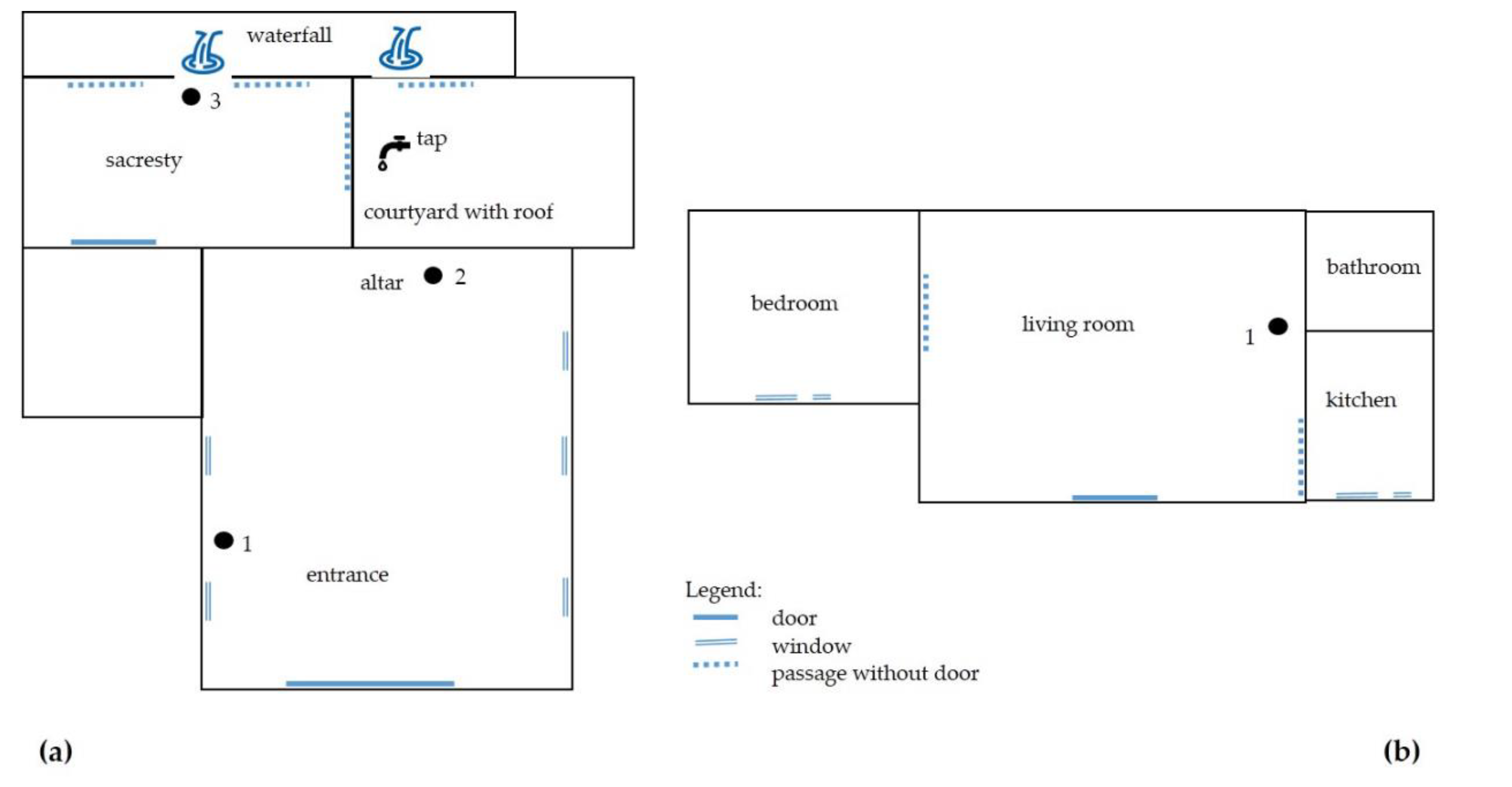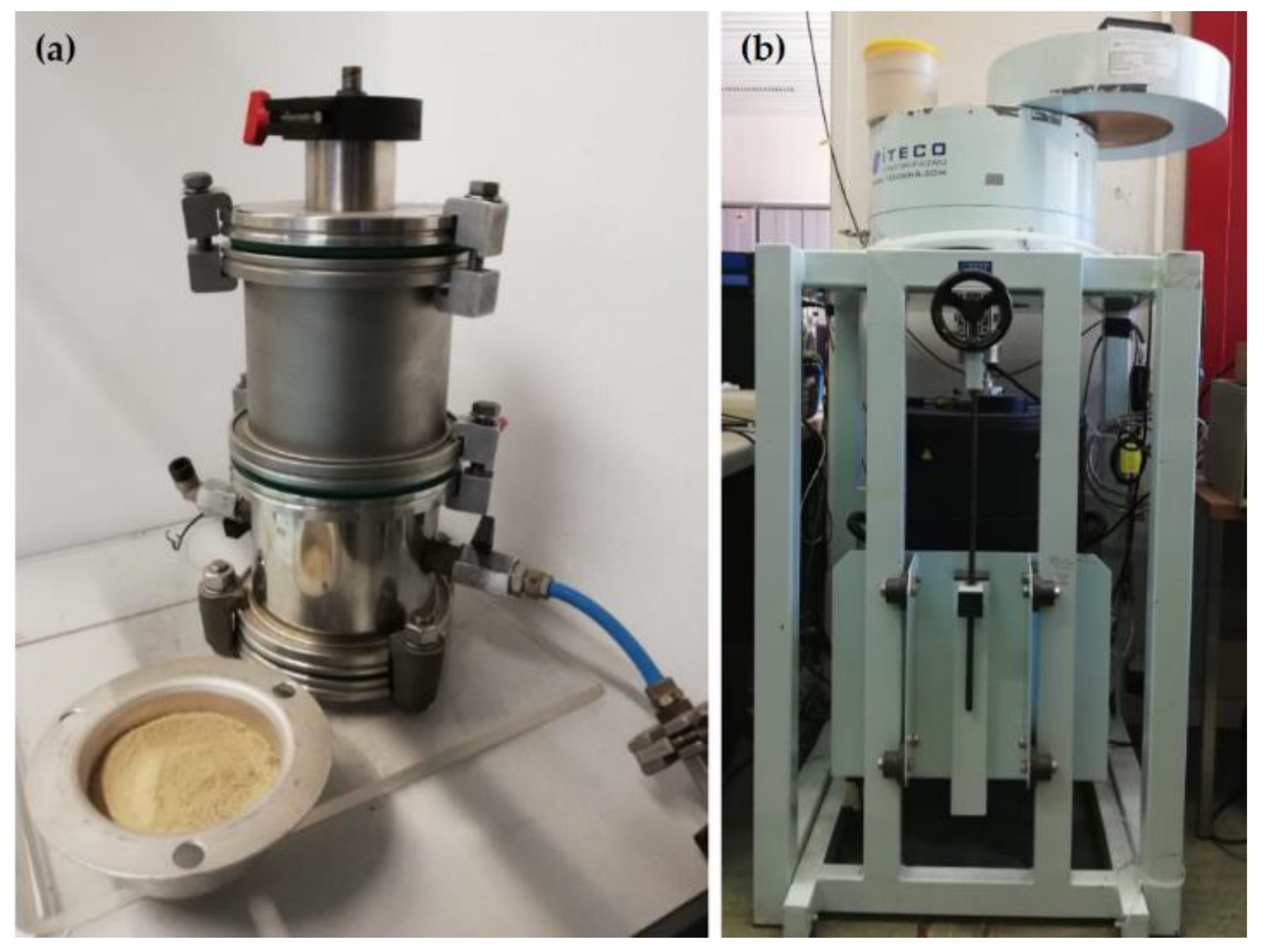Radiation Protection Legislation and Sustainable Development of a Rural Green Tuff Village of Ischia Island
Abstract
1. Introduction and Literature Review
2. Aim of the Study, Radon Issue and Legislative Background
3. Materials and Methods
3.1. Traditional Rural Buildings Selected for Radon Concentration Measurements
3.2. Measurement of Radon Activity Concentration in Air
- Vi and Vf: electret voltage readings before and after exposure respectively;
- T: exposure time in days;
- Gγ: gamma dose rate in µR h−1;
- C1 = 0.59, C2 = 0.02383, C3 = 0.0000112: constants given by the manufacturer depending on configuration and volume of the E-Perm chamber.
3.3. Measurement of Radon Activity Concentration in Water
- CRn: radon concentration measured in the air inside the jar by Equations (1) and (2) where C1 = 0.097, C2 = 1.670, C3 = 0.0005742;
- B1: period between the collection of the water sample and the start of the measurement;
- B2: period from the time of inserting the sampling bottle into the jar until the E-Perm is removed;
- B3: ratio between the volume of the jar and the water sample.
3.4. Calculation of Annual Effective Radon Dose
- CRn: indoor radon concentration (Bq m−3);
- O: occupancy factor (2000 h y−1 at work);
- D: dose coefficient.
3.5. Emanation Coefficient
3.5.1. Sample Preparation
3.5.2. Emanation Coefficient Measurement
4. Results
5. Discussion
6. Conclusions
Author Contributions
Funding
Conflicts of Interest
References
- Battino, S.; Lampreu, S. The Role of the Sharing Economy for a Sustainable and Innovative Development of Rural Areas: A Case Study in Sardinia (Italy). Sustainability 2019, 11, 3004. [Google Scholar] [CrossRef]
- Benni, S.; Carfagna, E.; Torreggiani, D.; Maino, E.; Bovo, M.; Tassinari, P. Multidimensional Measurement of the Level of Consistency of Farm Buildings with Rural Heritage: A Methodology Tested on an Italian Case Study. Sustainability 2019, 11, 4242. [Google Scholar] [CrossRef]
- Bryant, M.; Allan, P.; Kebbel, S. A Settlers’ Guide: Designing for Resilience in the Hinterlands. Buildings 2017, 7, 23. [Google Scholar] [CrossRef]
- Pitts, A. Establishing Priorities for Sustainable Environmental Design in the Rural Villages of Yunnan, China. Buildings 2016, 6, 32. [Google Scholar] [CrossRef]
- Ragheb, A.; El-Shimy, H.; Ragheb, G. Green architecture: A concept of sustainability. Procedia-Soc. Behav. Sci. 2016, 216, 778–787. [Google Scholar] [CrossRef]
- Cattaneo, T.; Giorgi, M.; Ni, M.; Manzoni, G.D. Sustainable Development of Rural Areas in the EU and China: A Common Strategy for Architectural Design, Research Practice and Decision-Making. Buildings 2016, 6, 42. [Google Scholar] [CrossRef]
- Palliyaguru, R.; Karunasena, G.; Ang, S. Review on Sustainable Building Design and Construction in the Rural Context: The Case of Building Ampara, Sri Lanka. In Sustainable Development Research in the Asia-Pacific Region. World Sustainability Series; Springer: Cham, Switzerland, 2018; pp. 493–507. [Google Scholar] [CrossRef]
- Picuno, P. Use of traditional material in farm buildings for a sustainable rural environment. Int. J. Sustain. Built Environ. 2016, 5, 451–460. [Google Scholar] [CrossRef]
- Usta, P.; Arıcı, A.; Evci, A.; Kepenek, E. Sustainability of traditional buildings located in rural area. Period. Eng. Nat. Sci. 2017, 5, 231–236. [Google Scholar] [CrossRef]
- Berardi, U. Clarifying the new interpretations of the concept of sustainable building. Sustain. Cities Soc. 2013, 8, 72–78. [Google Scholar] [CrossRef]
- Mateus, R.; Bragança, L. Sustainability assessment and rating of buildings: Developing the methodology SBToolPT-H. Build. Environ. 2011, 46. [Google Scholar] [CrossRef]
- Agnoletti, M.; Emanueli, F.; Corrieri, F.; Venturi, M.; Santoro, A. Monitoring Traditional Rural Landscapes. The Case of Italy. Sustainability 2019, 11, 6107. [Google Scholar] [CrossRef]
- Di Fazio, S.; Modica, G. Historic Rural Landscapes: Sustainable Planning Strategies and Action Criteria. The Italian Experience in the Global and European Context. Sustainibility 2018, 10, 3834. [Google Scholar] [CrossRef]
- Picuno, C.A.; Laković, I.; Roubis, D.; Picuno, P.; Kapetanović, A. Analysis of the Characteristics of Traditional Rural Constructions for Animal Corrals in the Adriatic-Ionian Area. Sustainability 2017, 9, 1441. [Google Scholar] [CrossRef]
- Treu, M.C.; Magoni, M.F.; Steiner, F.; Palazzo, D. Sustainable landscape planning for Cremona, Italy. Landsc. Urban Plan. 2000, 47, 79–98. [Google Scholar] [CrossRef]
- Torreggiani, D.; Tassinari, P. Landscape quality of farm buildings: The evolution of the design approach in Italy. J. Cult. Herit. 2012, 13, 59–68. [Google Scholar] [CrossRef]
- Garau, C. Perspectives on Cultural and Sustainable Rural Tourism in a Smart Region: The Case Study of Marmilla in Sardinia (Italy). Sustainability 2015, 7, 6412–6434. [Google Scholar] [CrossRef]
- European Network for Rural Development. Project Brochure “Smart and Competitive Rural Areas”, Luxembourg, Ufficio di Pubblicazioni dell’Unione Europea. Available online: https://enrd.ec.europa.eu/sites/enrd/files/publi-eafrd-brochure-02-en_2016.pdf (accessed on 27 August 2020).
- Kelliher, F.; Reinl, L.; Johnson, T.G.; Joppe, M. The role of trust in building rural tourism micro firm network engagement: A multi-case study. Tour. Manag. 2018, 68, 1–12. [Google Scholar] [CrossRef]
- Porto, S.M.C.; Leanza, P.; Cascone, G. Developing Interpretation Plans to Promote Traditional Rural Buildings as Built Heritage Attractions. Int. J. Tour. Res. 2012, 14, 421–436. [Google Scholar] [CrossRef]
- Santucci, F.M. Agritourism for Rural Development in Italy, Evolution, Situation and Perspectives. Br. J. Econ. Manag. Trade 2013, 3, 186–200. [Google Scholar] [CrossRef]
- Gillot, P.-Y.; Chiesa, S.; Pasquaré, G.; Vezzoli, L. <33,000-yr K–Ar dating of the volcano–tectonic horst of the Isle of Ischia, Gulf of Naples. Nature 1982, 299, 242–245. [Google Scholar] [CrossRef]
- Altaner, S.; Demosthenous, C.; Pozzuoli, A.; Rolandi, G. Alteration history of Mount Epomeo Green Tuff and a related polymictic breccia, Ischia Island, Italy: Evidence for debris avalanche. Bull. Volcanol. 2013, 75. [Google Scholar] [CrossRef]
- Decreto Legislativo n. 241 del 26 Maggio 2000, Attuazione Della Direttiva 96/29/EURATOM in Materia di Protezione Sanitaria Della Popolazione e dei Lavoratori Contro i Rischi Derivanti Dalle Radiazioni Ionizzanti; Gazz. Uff n. 203: Roma, Italy, 2000.
- European Council. European Council Directive 2013/59/Euratom on basic safety standards for protection against the dangers arising from exposure to ionising radiation and repealing Directives 89/618/Euratom, 90/641/Euratom, 96/29/Euratom, 97/43/Euratom and 2003/122/Euratom. OJ EU 2014, 13, 1–73. [Google Scholar]
- Durante, M.; Grossi, G.F.; Napolitano, M.; Pugliese, M.; Gialanella, G. Chromosome-Damage Induced by High-Let Alpha-Particles in Plateau-Phase C3h 10t1/2 Cells. Int. J. Radiat. Biol. 1992, 62, 571–580. [Google Scholar] [CrossRef] [PubMed]
- International Commission on Radiological Protection (ICRP). Man-made Mineral Fibres and Radon. In IARC Monographs on the Evaluation of Carcinogenic Risks to Humans; IARC: Lyon, France, 1988; Volume 43, pp. 1–300. [Google Scholar]
- World Heath Organization (WHO). WHO Handbook on Indoor Radon: A Public Health Perspective. In WHO Guidelines Approved by the Guidelines Review Committee; World Health Organization: Geneva, Switzerland, 2009. [Google Scholar]
- International Commission on Radiological Protection (ICRP). Protection of the public in situations of prolonged radiation exposure. The application of the Commission’s system of radiological protection to controllable radiation exposure due to natural sources and long-lived radioactive residues. Ann. ICRP 1999, 29, 1–109. [Google Scholar]
- United Nations. Scientific Committee on the Effects of Atomic Radiation (UNSCEAR). Sources and Effects of Ionizing Radiation: United Nations Scientific Committee on the Effects of Atomic Radiation: UNSCEAR 2000 Report to the General Assembly, with Scientific Annexes; United Nations: New York, NY, USA, 2000. [Google Scholar]
- La Verde, G.; Raulo, A.; D’Avino, V.; Roca, V.; Pugliese, M. Radioactivity content in natural stones used as building materials in Puglia region analysed by high resolution gamma-ray spectroscopy: Preliminary results. Constr. Build. Mater. 2020, 239. [Google Scholar] [CrossRef]
- Decreto Legislativo 15 Febbraio 2016, n. 28. Attuazione Della Direttiva 2013/51/EURATOM del Consiglio, del 22 Ottobre 2013, che Stabilisce Requisiti per la Tutela Della Salute Della Popolazione Relativamente Alle Sostanze Radioattive Presenti Nelle Acque Destinate al Consumo Umano; Gazz. Uff n. 55: Roma, Italy, 2016.
- Bochicchio, F.; Campos-Venuti, G.; Piermattei, S.; Nuccetelli, C.; Risica, S.; Tommasino, L.; Torri, G.; Magnoni, M.; Agnesod, G.; Sgorbati, G.; et al. Annual average and seasonal variations of residential radon concentration for all the Italian Regions. Radiat. Meas. 2005, 40, 686–694. [Google Scholar] [CrossRef]
- Pugliese, M.; Quarto, M.; Loffredo, F.; Mazzella, A.; Roca, V. Indoor Radon Concentrations in Dwellings of Ischia Island. J. Environ. Prot. 2013, 4, 37–39. [Google Scholar] [CrossRef]
- Rossetti, M.; Esposito, M. Radon levels in underground workplaces: A map of the Italian regions. Radiat. Prot. Dosim. 2014, 164, 392–397. [Google Scholar] [CrossRef]
- Pugliese, M.; Quarto, M.; De Cicco, F.; De Sterlich, C.; Roca, V. Radon Exposure Assessment for Sewerage System’s Workers in Naples, South Italy. Indoor Built Environ. 2013, 22, 575–579. [Google Scholar] [CrossRef]
- Azara, A.; Dettori, M.; Castiglia, P.; Piana, A.; Durando, P.; Parodi, V.; Salis, G.; Saderi, L.; Sotgiu, G. Indoor Radon Exposure in Italian Schools. Int. J. Environ. Res. Public Health 2018, 15, 749. [Google Scholar] [CrossRef]
- Gaidolfi, L.; Malisan, M.R.; Bucci, S.; Cappai, M.; Bonomi, M.; Verdi, L.; Bochicchio, F. Radon measurements in kindergartens and schools of six italian regions. Radiat. Prot. Dosim. 1998, 78, 73–76. [Google Scholar] [CrossRef]
- Giovani, C.; Cappelletto, C.; Garavaglia, M.; Scruzzi, E.; Peressini, G.; Villalta, R. Radon survey in schools in north-east Italy. Radiat. Prot. Dosim. 2001, 97, 341–344. [Google Scholar] [CrossRef] [PubMed]
- Venoso, G.; De Cicco, F.; Flores, B.; Gialanella, L.; Pugliese, M.; Roca, V.; Sabbarese, C. Radon concentrations in schools of the Neapolitan area. Radiat. Meas. 2009, 44, 127–130. [Google Scholar] [CrossRef]
- Pugliese, M.; Quarto, M.; Roca, V. Radon concentrations in air and water in the thermal spas of Ischia Island. Indoor Built Environ. 2013, 23, 823–827. [Google Scholar] [CrossRef]
- Kotrappa, P. E-Perm Electret Ion Chambers for Measuring Radon in Water. In E-Perm System Training Manual; Rad Elec Inc.: Frederick, MD, USA, 1998. [Google Scholar]
- Kotrappa, P.; Dempsey, J.C.; Hickey, J.R.; Stieff, L.R. An electret passive environmental 222Rn monitor based on ionization measurement. Health Phys. 1988, 54, 47–56. [Google Scholar] [CrossRef]
- Kotrappa, P.; Dempsey, J.C.; Ramsey, R.W.; Stief, L.R. A practical E-PERM (Electret Passive Environmental Radon Monitor) System for Indoor 222Rn Measurement. Health Phys. 1990, 58, 461–467. [Google Scholar] [CrossRef]
- Kotrappa, P.; Jester, W.A. Electret ion chamber radon monitors measure dissolved 222Rn in water. Health Phys. 1993, 64, 397–405. [Google Scholar] [CrossRef]
- La Verde, G.; Roca, V.; Pugliese, M. Quality assurance in planning a radon measurement survey using PDCA cycle approach: What improvements? Int. J. Metrol. Qual. Eng. 2019, 10, 1–6. [Google Scholar] [CrossRef]
- La Verde, G.; Roca, V.; Sabbarese, C.; Ambrosino, F.; Pugliese, M. The equilibrium factor in the radon dose calculation in the archaeological site of Acquedotto Augusteo del Serino in Naples. NcimC 2018, 41, 6. [Google Scholar] [CrossRef]
- Decreto Legislativo n. 101 del 31 Luglio 2020, Attuazione Della Direttiva 2013/59/Euratom, che Stabilisce Norme Fondamentali di Sicurezza Relative Alla Protezione Contro i Pericoli Derivanti Dall’esposizione Alle Radiazioni Ionizzanti, e che Abroga le Direttive 89/618/Euratom, 90/641/Euratom, 96/29/Euratom, 97/43/Euratom e 2003/122/Euratom e riordino Della Normativa di Settore in Attuazione dell’articolo 20, Comma 1, Lettera A), Della Legge 4 Ottobre 2019; n. 117; Gazz. Uff n. 201: Roma, Italy, 2020.
- Quarto, M.; Pugliese, M.; Loffredo, F.; Roca, V. Indoor Radon Concentration Measurements in Some Dwellings of the Penisola Sorrentina, South Italy. Radiat. Prot. Dosim. 2013, 156, 207–212. [Google Scholar] [CrossRef]
- D’Avino, V.; Pugliese, M.; La Verde, G. Effectiveness of passive ventilation on radon indoor level in Puglia Region according to European Directive 2013/59/EURATOM. Indoor Built Environ. 2020. [Google Scholar] [CrossRef]
- Roca, V.; Pugliese, M.; Sabbarese, C.; D‘Onofrio, A.; Lubritto, C.; Terrasi, F.; Ermice, A.; Inglima, I.; Migliore, G. Natural radioactivity of building materials coming from a volcanic region. In Proceedings of the European Conference on Protection Against Radon at Home and at Work, Prague, Czech Republic, 28 June–2 July 2004; pp. 348–354. [Google Scholar]
- Nuccetelli, C.; Risica, S.; Onisei, S.; Leonardi, F.; Trevisi, R. Natural Radioactivity in Building Materials in the European Union: A Database of Activity Concentrations, Radon Emanations and Radon Exhalation Rates: Rapporti ISTISAN 17/36; Istituto Superiore di Sanità: Roma, Italy, 2017. [Google Scholar]
- Maggiore, G.; De Filippis, G.; Totaro, T.; Tamborino, B.; Idolo, A.; Serio, F.; Castorini, I.F.; Valenzano, B.; Riccio, A.; Miani, A.; et al. Evaluation of radon exposure risk and lung cancer incidence/mortality in South-eastern Italy. J. Prev. Med. Hyg. 2020, 61, E31–E38. [Google Scholar] [CrossRef] [PubMed]
- Ferri, G.M.; Intranuovo, G.; Cavone, D.; Corrado, V.; Birtolo, F.; Tricase, P.; Fuso, R.; Vilardi, V.; Sumerano, M.; L‘Abbate, N.; et al. Estimates of the Lung Cancer Cases Attributable to Radon in Municipalities of Two Apulia Provinces (Italy) and Assessment of Main Exposure Determinants. Int. J. Environ. Res. Public Health 2018, 15, 1294. [Google Scholar] [CrossRef] [PubMed]
- Ministry of Cultural Heritage and Activities. Approvazione del Piano Territoriale Paesistico Isola d’Ischia; Gazz. Uff n. 94: Roma, Italy, 1999. [Google Scholar]





| Measurement Point | Activity Radon Concentration (Bq/m3) | |
|---|---|---|
| church | dwelling | |
| #1 | 210 ± 20 | 210 ± 20 |
| #2 | 120 ± 20 | |
| #3 | 540 ± 40 | |
© 2020 by the authors. Licensee MDPI, Basel, Switzerland. This article is an open access article distributed under the terms and conditions of the Creative Commons Attribution (CC BY) license (http://creativecommons.org/licenses/by/4.0/).
Share and Cite
La Verde, G.; D’Avino, V.; Sabbarese, C.; Ambrosino, F.; Roca, V.; Raulo, A.; Pugliese, M. Radiation Protection Legislation and Sustainable Development of a Rural Green Tuff Village of Ischia Island. Sustainability 2020, 12, 8374. https://doi.org/10.3390/su12208374
La Verde G, D’Avino V, Sabbarese C, Ambrosino F, Roca V, Raulo A, Pugliese M. Radiation Protection Legislation and Sustainable Development of a Rural Green Tuff Village of Ischia Island. Sustainability. 2020; 12(20):8374. https://doi.org/10.3390/su12208374
Chicago/Turabian StyleLa Verde, Giuseppe, Vittoria D’Avino, Carlo Sabbarese, Fabrizio Ambrosino, Vincenzo Roca, Adelaide Raulo, and Mariagabriella Pugliese. 2020. "Radiation Protection Legislation and Sustainable Development of a Rural Green Tuff Village of Ischia Island" Sustainability 12, no. 20: 8374. https://doi.org/10.3390/su12208374
APA StyleLa Verde, G., D’Avino, V., Sabbarese, C., Ambrosino, F., Roca, V., Raulo, A., & Pugliese, M. (2020). Radiation Protection Legislation and Sustainable Development of a Rural Green Tuff Village of Ischia Island. Sustainability, 12(20), 8374. https://doi.org/10.3390/su12208374








